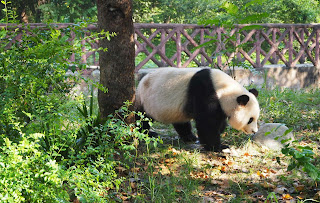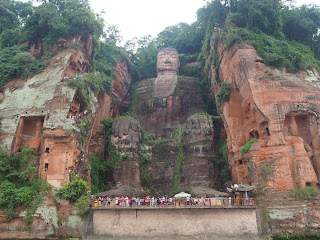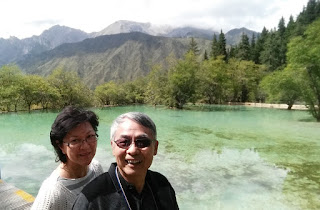Panda, the National Animal of China is probably the most lovable and adorable animal in the world. Our itinerary in Chengdu includes a visit to Chengdu Panda Research Base for Giant Panda. We managed to see the Panda but not after much "struggle" for space with the massive crowd thronging the Centre that day.
That was not the first time I saw Panda. I had the opportunity of not just seeing Panda but "cuddling" one when I visited the Chongqing Zoo in 1993 with tour members of the Institution of Engineers Malaysia.
This time, I was surprised to learn that there is such animal called "Red Panda" beside the Giant Panda. The Red Panda is more like raccoon than the usual black and white Panda that we are accustomed to. For the Chinese names of Giant Panda and Red Panda, they are being referred to as "Big Panda" and the "Small Panda". Other than the name, they are in actual fact of different species. The only similar thing they share is probably they both eat bamboo. The Red Panda is said to be a more fearsome animal compared to their much loved cousins. Understandably, cuddling a Red Panda is not one of the "To Do Things" in this Centre.
I can't remember paying a substantial fee to cuddle a Panda way back in 1993. But now in Chengdu Research Base, it will cost Panda lovers a whooping RMB2,000 to cuddle one. I can fully appreciate the rationale of imposing such massive fee. Any "affordable" fee would have flooded the Research Base with all sorts of people and the poor Panda would probably have fallen ill because of stress and lack of rest just to entertain such massive crowd.
I was impressed by what the Chinese are doing to protect this endangered species in this Centre. The RMB2,000 which is also called "donation" is just one way Panda lovers can do in the conservation effort of this animal!
I can't remember paying a substantial fee to cuddle a Panda way back in 1993. But now in Chengdu Research Base, it will cost Panda lovers a whooping RMB2,000 to cuddle one. I can fully appreciate the rationale of imposing such massive fee. Any "affordable" fee would have flooded the Research Base with all sorts of people and the poor Panda would probably have fallen ill because of stress and lack of rest just to entertain such massive crowd.
I was impressed by what the Chinese are doing to protect this endangered species in this Centre. The RMB2,000 which is also called "donation" is just one way Panda lovers can do in the conservation effort of this animal!
 |
| Red Panda. |
A tourist after paying RMB2,000 and donning full gear of sanitary protective clothing, cap and surgical mask would have the luxury of watching and examining the Panda at close range.
*******************************************************
I can't recall paying any major fee to cuddle a Panda in Chongqing Zoo in 1993. That was 23 years ago!



















































